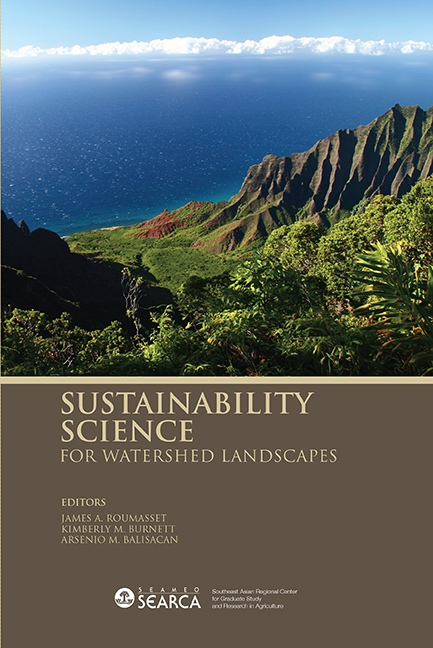Book contents
- Frontmatter
- Contents
- Tables
- Figures
- Message
- Foreword
- Preface
- Acknowledgments
- List of Contributors
- Theme 1 Sustainability Science for Resource Management and Policy
- Theme 2 Monitoring and Modelling
- Theme 3 Participatory Approaches
- Theme 4 Case Studies
- 10 Changing Land Use in the Golden Triangle: Where the Rubber Meets the Road
- 11 Effects of Feral Pigs (Sus scrofa) on Watershed Health in Hawaiʿi: A Literature Review and Preliminary Results on Runoff and Erosion
- 12 Sustainable Water Quality Management for Pacific Island Watersheds: Illustrations from American Samoa, Hawaiʿi, and Micronesia
- 13 The Transboundary Management of Groundwater Resources in Kumamoto, Japan
- Synthesis
12 - Sustainable Water Quality Management for Pacific Island Watersheds: Illustrations from American Samoa, Hawaiʿi, and Micronesia
from Theme 4 - Case Studies
Published online by Cambridge University Press: 21 October 2015
- Frontmatter
- Contents
- Tables
- Figures
- Message
- Foreword
- Preface
- Acknowledgments
- List of Contributors
- Theme 1 Sustainability Science for Resource Management and Policy
- Theme 2 Monitoring and Modelling
- Theme 3 Participatory Approaches
- Theme 4 Case Studies
- 10 Changing Land Use in the Golden Triangle: Where the Rubber Meets the Road
- 11 Effects of Feral Pigs (Sus scrofa) on Watershed Health in Hawaiʿi: A Literature Review and Preliminary Results on Runoff and Erosion
- 12 Sustainable Water Quality Management for Pacific Island Watersheds: Illustrations from American Samoa, Hawaiʿi, and Micronesia
- 13 The Transboundary Management of Groundwater Resources in Kumamoto, Japan
- Synthesis
Summary
ABSTRACT
Clean and abundant water is fundamental to life. It supports natural ecosystems as well as human health and economic vitality. Pure fresh water is an essential resource. Its supply is often limited in island ecosystems. This chapter describes water quality protection and management in the American-affiliated Pacific Islands, with emphasis on the activities of a regional water programme supported by the Cooperative State Research, Education, and Extension Service of the US Department of Agriculture. The geology and hydrology of the Pacific islands is briefly reviewed. Public attitudes and concerns about water quality and pollution sources are presented based on a survey of island residents in 2004. These concerns directed the specific themes and activities of the regional water programme. Regional initiatives in water quality protection are presented as illustrations or actions being taken. These initiatives include drinking water safety from rainwater catchment, animal waste management, microbial contamination concerns, watershed management activities and coastal resource protection. Despite diverse cultures and conditions across the islands, there is much common “ground” (and water issues) and many benefits derived from building relationships, sharing resources, and working for mutual benefits.
E u-i aku ana au ia oe: Aia i-hea ka Wai a Kane?
Aia i-lalo, I ka honua, I ka Wai hu, I ka wai kau a Kane me Kanaloa,
He wai-puna, he wai e inu, He wai e mana, he wai e ola,
E ola no, e-a!
One question I ask of you: Where flows the water of Kane?
Deep in the ground, in the gushing spring, In the ducts of Kane and Kanaloa,
A well-spring of water, water to drink, Water to empower, Water to bring life,
Life! O give us this life!
– The Kumulipo: A Hawaiian Creation Chant (Emerson 1964)Clean and abundant water is fundamental to life, supporting natural ecosystems, as well as human health and economic vitality. Pure fresh water is an essential resource, which is often limited in supply in island ecosystems. There is a need to preserve water quality for human use and at the same time maintain natural ecosystems.
- Type
- Chapter
- Information
- Sustainability Science for Watershed Landscapes , pp. 279 - 310Publisher: ISEAS–Yusof Ishak InstitutePrint publication year: 2010



